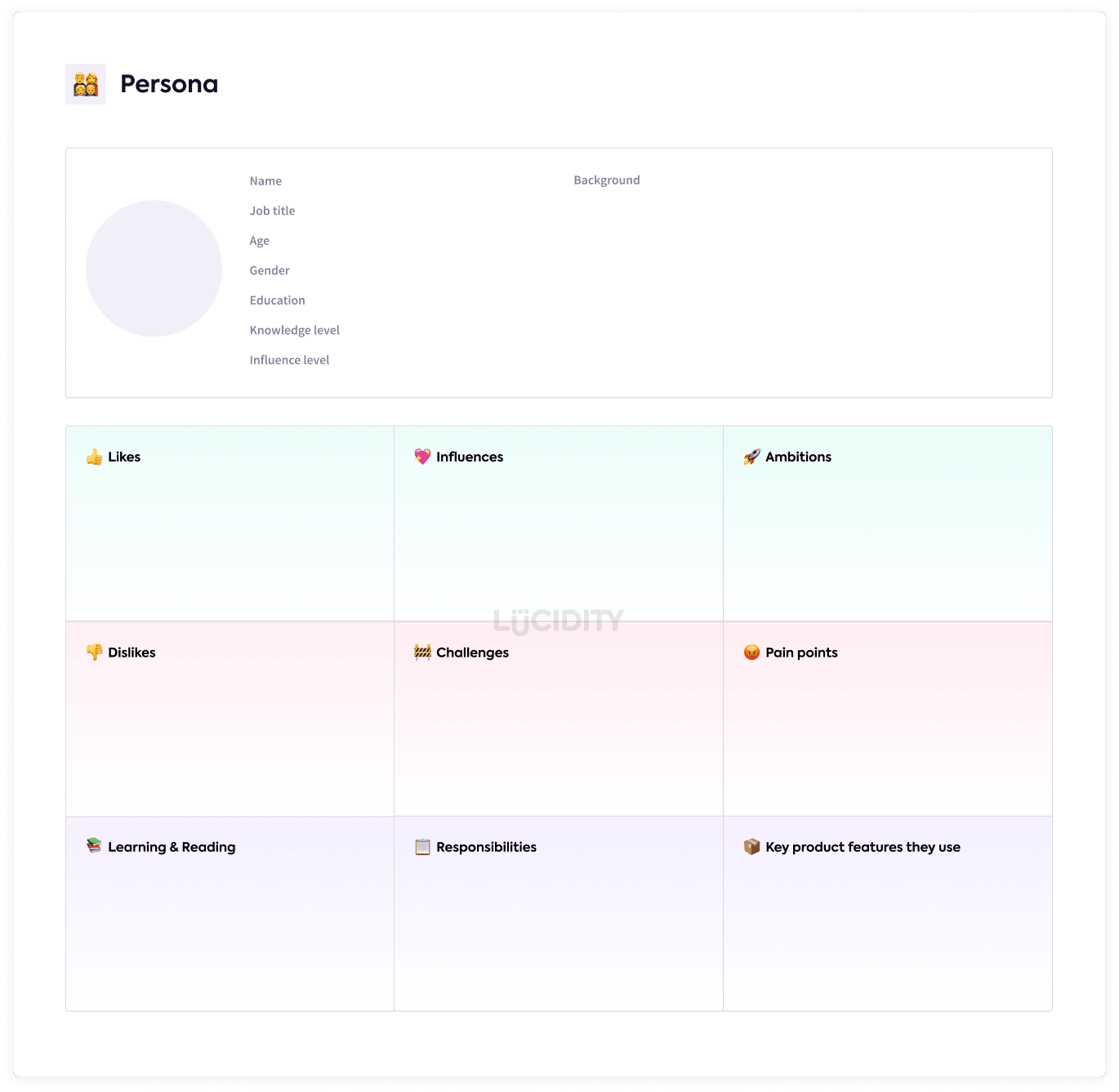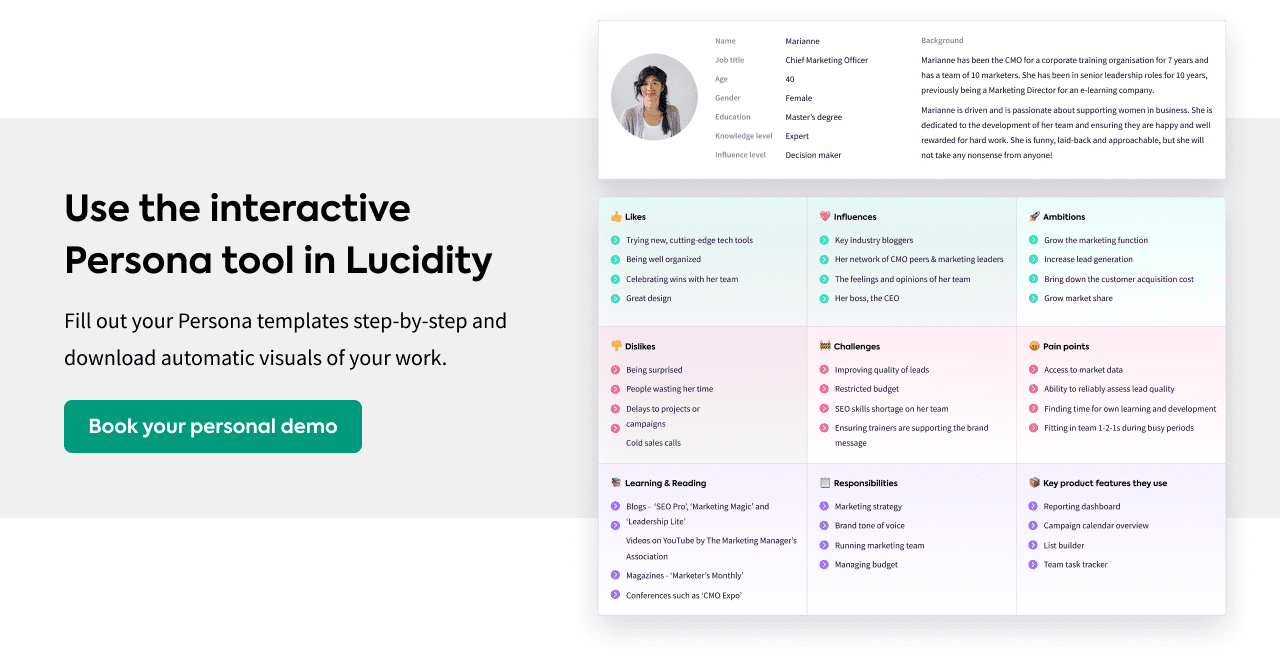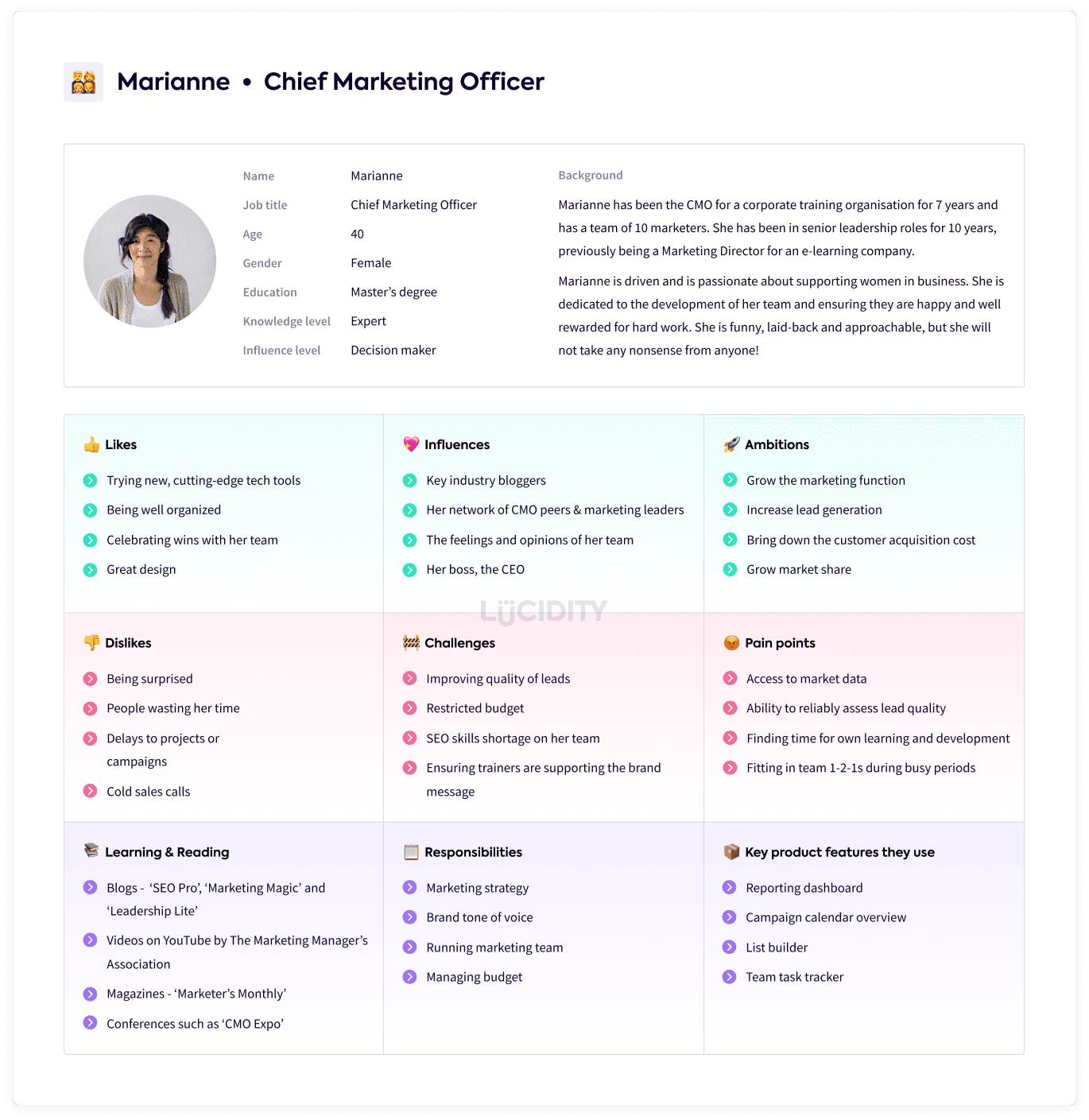When developing a marketing or product strategy it’s common to create personas to help your thinking. Personas can aid with strategic decision making, help raise customer awareness for team members, and be a great tool when shaping your sales messaging.
Let’s take a look at them in more detail…
What are personas?
Personas are fictional, generalised profiles or characters that you create to represent your typical, or even ideal, buyer, customer or user of your product or service.
With persona analysis you are creating single page profiles for these characters using a template that maps out things like demographics, responsibilities, goals, challenges, likes and dislikes. The objective of persona analysis is to paint a picture of your buyer, customer or user – to bring them to life and help your teams understand what makes them tick.
Why do persona analysis?
Creating personas for your business gives you a really useful, succinct summary of your target audience, customers and users. The exercise of creating personas will help you hone your understanding of who your customers are and give you a clear record to use across the business to raise customer awareness.
Personas are a great tool to get everyone on the same page and ensure there’s a consistent knowledge of who your buyers, customers and users are and what they want and need. They can be a fast and simple way to onboard new recruits and act as a refresher for everyone else whenever needed.
There are a couple of different types of personas a business might create, each for slightly different purposes. Although they often use the same template, listing out the same information for each persona, the characters themselves may be different.
Buyer Personas
Buyer personas, sometimes referred to as marketing personas, are representations of the people who actually make the decision to purchase your product or service. They are the most important persona for sales and marketing teams as having a deep understanding of what drives the people you’re trying to get to buy your product or service is the key to developing effective messaging.
With buyer personas you are focused on their wider lives and work in order to help you see how you can help them and where your product or service fits in. When creating a buyer persona you should be focused exclusively on that character and not on your product or service. For example, when listing out the ‘likes’ for a buyer persona, you should be thinking about what they ‘like’ in general, not what they like about your product in particular.
Creating buyer personas will help you understand your prospects’ priorities, responsibilities, goals, challenges and pain points. This understanding will help you hone your sales and marketing efforts, helping you position your offering and tailor your messaging. By understanding what’s important to your prospects, you stand the best chance of appealing to those priorities and getting their attention.
Conducting buyer persona analysis will also help you determine effective routes to that market. Be it where they go online, what events they attend, or even who influences them, the act of building a persona will give you a list of ways to access that character and help inform your marketing campaign planning.
User Personas
User personas are representations of the people who use your product or service. These may, or may not, be different from your buyer personas. Especially in B2B businesses, sometimes the person who makes the buying decision is not the person who will use your product day-to-day.
For example, if your product was software that helped developers code, then the buyer might be a CTO, whereas the user is more likely to be a developer. Therefore, your buyer persona would be a CTO, but you’d also need to create a user persona for a developer in order to help you understand their motivations and needs.
User personas can be more focused on your particular product or service. You want to capture the why and how when it comes to using your product. So, with user personas the ‘likes’ can be more focused on what they like about your solution.
Having said that, you don’t want to exclusively focus on their interaction with your product. It’s important to capture a bit of information that helps paint a picture of what their wider roles, responsibilities and challenges are so you’re able to potentially expand your solution, look for new opportunities or see things you hadn’t previously thought of.
User personas are commonly conducted by product teams and used to help decision making in product development. They are extremely useful for raising customer awareness with product team members and focusing their ideas and work around what will help make their users lives better.
Both buyer personas and user personas are an important tool when developing both your customer acquisition and retention strategies.
What research do you need to do to create personas?
Your personas should be based on research into your audience. Depending on your resources, the time you have and your experience of the market, there are different levels you can go to and different tactics to get the insight you need.
Ways to gather information and insight may include:
- Examining customer data and looking for the commonalities in things like job titles, demographics, industries, company size
- Going through existing customer feedback, looking for trends in both positive and negative comments
- Conducting customer interviews or surveying your database
- Speaking to the customer-facing people in your business and capturing their insights and observations
- Commissioning in-depth market research
Gather together as much information and insight into your buyers, customers and users as you can before sitting down to create your personas.
How many personas should you have?
The first job to do when it comes to creating your own personas is to decide which personas you need. Whether you’re building buyer or user personas you’ll need to look through your research and try to boil down your customer types to as few as possible.
Remember, personas are generalised representations and you do not need a new persona for every nuisance across your customer types.
If you have too many personas it will be hard for your teams to remember them and difficult to focus. Certainly, with buyer personas, the holy grail for marketers is to have just one or two personas so you’re able to truly focus and specialise and not spread your efforts and attention thinly over multiple audiences. In reality, however, most businesses will have more than one or two personas, but we recommend trying to keep the numbers down as much as possible.
What does a persona template contain?
For each persona you will create a one-page profile, completing a template that includes demographics, behaviours, needs and aspirations.
Given their use, it’s important the persona information is easy to consume and quick to access. Personas are used by a wide range of people within a business and should therefore be a succinct summary.
The categories inside a persona template are:
- Demographics
- Job Role & Responsibilities
- Personality
Remember, you can find many examples of personas in Lucidity! 😎
What are Demographics in a persona template?
The demographical information in a persona profile are an important part of creating and bringing to list a fictional character. Giving your persona demographics helps you and your team understand the audience you are working with, their background, and gives life to the character you are developing. Some example traits you may cover in a persona include:
- Age
- Gender
- Marital Status
- Location
- Background
- Family (e.g. children)
- Social use of technology
What are the Personality traits in a persona?
The personality information in a persona profile is important when it comes to creating your messaging for that audience. You’re starting to weave in an understanding of how your personas may think in their day-to day-roles. This knowledge will help your marketers develop the right tone and appeal to the right drivers.
Attributes you may record against the Personality of your persona include:
- Likes
- Dislikes
- Worries
- Fears
- Personality type
- Influences
- Learning sources
- Hobbies and interests
What are the Job traits in a persona template?
Of course, a really important part of your persona analysis are the job traits. This is where a lot of your core messaging will stem from and covers areas such as challenges and pain points. It’s arguably the most important aspect of a persona.
Job traits may include areas such as:
- Job title
- Department
- Responsibilities
- Challenges
- Pain Points
- Technology used
- Motivations
- Goals
Is there a difference between B2B and B2C personas?
Although it’s a nice idea to flesh out all personas and bring them to life with extra information, if you’re a B2B business, there’s not a lot of point in describing in great detail the pets your Financial Director persona has.
Similarly, if you are B2C and have, say, a golf product, there’s little point exhaustively listing out the challenges your ‘High Flying Business Leader’ persona might have when it comes to access to market data.
It’s important to just capture the information about your persona that is going to help you understand them better in order to help them improve their lives with your product or service.
For the most part, you can use the same persona template whether you’re creating a persona for B2C or B2B, but you will just answer differently depending on whether you’re focusing on their working life or home life.
An Example Persona: Chief Marketing Officer
It always helps to have examples! So, here we’ve created a persona for a Chief Marketing Officer. Keep in mind, if you are creating a Chief Marketing Officer persona, it may be slightly different, as it’ll depend on your industry or sector.
Let’s begin with Demographics. Here we’ve given our persona a name, age, gender and photo. We’ve decided on their education level, knowledge level of the company product, and their influence within their own organization. We’ve also provided a short background to the persona explaining where they came from and their previous experience.
We’re now going to look at their profile, starting with their preferences. Some of the things this persona likes are…
- Trying new, cutting-edge tech tools
- Being well organized
- Celebrating wins with her team
- Great design
Some of the things they dislike…
- Being surprised
- People wasting her time
- Delays to projects or campaigns
- Cold sales calls
The next step is to add in some learning and reading.
- Read blogs such as ‘SEO Pro’, ‘Marketing Magic’ and ‘Leadership Lite’
- Watches videos on YouTube by The Marketing Manager’s Association
- Reads magazines such as ‘Marketer’s Monthly’
- Attends conferences such as ‘CMO Expo’
Finally, we’ve considered what influences this persona…
- Key industry bloggers
- Her network of CMO peers and marketing leaders
- The feelings and opinions of her team
- Her boss, the CEO
At this point we’ve built up the character of our persona, so it’s now time to flesh out some of their work. Let’s look at their challenges at work. For a CMO perhaps it’s quality of leads or restricted budget?
- Improving quality of leads
- Restricted budget
- SEO skills shortage on her team
Responsibilities is a key part of any persona. For our CMO we can add some obvious ones such as…
Marketing strategy
- Brand tone of voice
- Running marketing team
- Managing budget
Good personas always have ambitions. So, what would our CMO have here? We’ve added a few…
- Grow the marketing function
- Increase lead generation
- Bring down the customer acquisition cost
- Grow market share
To round up, let’s look at Pain Points. What are the areas of their professional life causing them pain?
- Access to market data
- Ability to reliably assess lead quality
- Finding time for own learning and development
As a final point, it’s useful to also list the features the persona would use in your product or service, in order to highlight the areas of your solution that are most important to them.
Here’s the persona in full…
Who invented personas?
Personas originated in the software design world and were first introduced by Alan Cooper in his book The Inmates Are Running the Asylum which focused on the need to think more about the intended user when designing software. He suggested that forming a real understanding of the user in the form of a persona would help developers envisage how their product might be used and therefore build more user-friendly products.
Cooper later moved into consulting and that’s when he identified the need to pull these personas into formal documents that he could leave behind. That was the birth of the persona template.
Final words
Personas are a simple and very effective way of capturing insight into your prospects and customers in order to inform your teams and drive better targeting, service and product design. The real beauty of a persona comes in its succinctness – from reading this single page of information someone in your organisation can quickly start to form a fairly detailed picture of your audience.
One final thing to remember with personas is that they should not be static. The best personas are the ones that get revisited regularly and updated based on new knowledge, better understanding, market changes and consumer trends.















